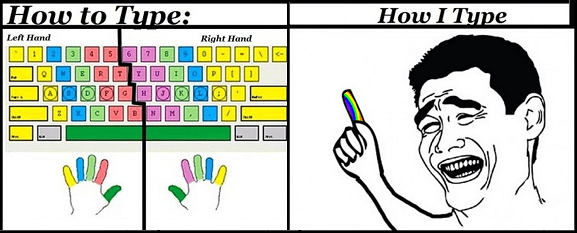

Typing with 10 fingers will strengthen your hands and improve your overall dexterity. It's usually not a problem in the short term (unless you're typing all day), but it does get worse over time. You'll find yourself in pain if you're typing incorrectly for too long, like when you type without the other eight fingers. It's a painful condition that makes it difficult for your fingers and wrists to move. The second benefit is that you'll be able to type all day without getting carpal tunnel syndrome. Since it's so easy to carry around these devices, you can write anywhere! You can quickly type these documents on your laptop or tablet while sitting in the airport lounge, riding the bus, or having coffee with your friend. The first benefit is that you'll be able to write reports, essays, and emails without sitting at a computer all day long. There are many benefits to typing efficiently and fast.
#Ten fast typing fingers tv#
It requires practice at first, but you'll soon be able to type without looking at the keys! This is an essential skill, especially for those who like to watch TV or read books while typing. If you ever find yourself staring at your screen while typing but can't think of what to type next because your fingers are taking too long to find the right keys, you're obviously not typing fast enough. Typing with ten fingers makes it easier to touch type, which means you tap your fingers on the keys without looking at them. Because you're not taking a longer path, you won't make mistakes or make fewer mistakes! You'll move the correct finger to the right key almost every time! For example, if you want to press the "S" letter, it should be your ring finger that presses down on the key instead of the index finger. Using all of your fingers reduces the fingers' traveling distance, and that's how it saves time. If you're not yet proficient with all ten fingers, then you might find that it takes longer than usual for your fingers to travel from key to key. Most people only use their index fingers, and this forces them to hunt and peck their way around the keyboard. That might sound like an unnecessary skill, but if you learn to use the other eight fingers on both hands (and yes, that's possible!), you'll be able to type up to twice as fast while making fewer errors. Typing with all ten fingers simply means you're typing not only by using your two index fingers. Learning this technique takes only a few months and will make your life easier and save a lot of time for you! What does it mean to 10 fingers typing? What muscles are used to type with 10 fingers?īut have you ever thought about how much more efficient your typing would be if you had more than two hands? If you're like most people, it'll come as a surprise that there are actually ten fingers on both hands - not just the index fingers! And when they're used effectively, all ten can increase your typing speed exponentially while reducing mistakes by up to 75%.Why should you learn 10 fingers typing?.If the standard is changed, all touch typists would have to relearn and spend a considerable number of hours training for the new layout. Though the standard QWERTY keyboard is said to have room for improvement in terms of speed and ease of typing, it is said that this change has been resisted by touch typists everywhere because of familiarity. The design of the QWERTY keyboard, for the English language, ensures that letters that are commonly pressed or used in succession are as far away as possible to promote speed and the use of both hands, thereby distributing strain to all fingers rather than just a few.

On most modern keyboards the home keys for each index finger have a raised bar or dot to help the touch typist to maintain and recover the correct position of the fingers on the keyboard quickly without having to look at the keys.Įach finger of each hand has dedicated keys assigned to it which it can easily reach. Touch typing is done using a standard QWERTY keyboard with the hands placed at a starting location, called the "home row keys." The home row keys for the left hand are the "ASDF" keys, and are "JKL " for the right hand. Touch typing was said to have been invented by a court stenographer from Salt Lake City, Utah named Frank Edward McGurrin in 1888 while teaching typing classes.


 0 kommentar(er)
0 kommentar(er)
